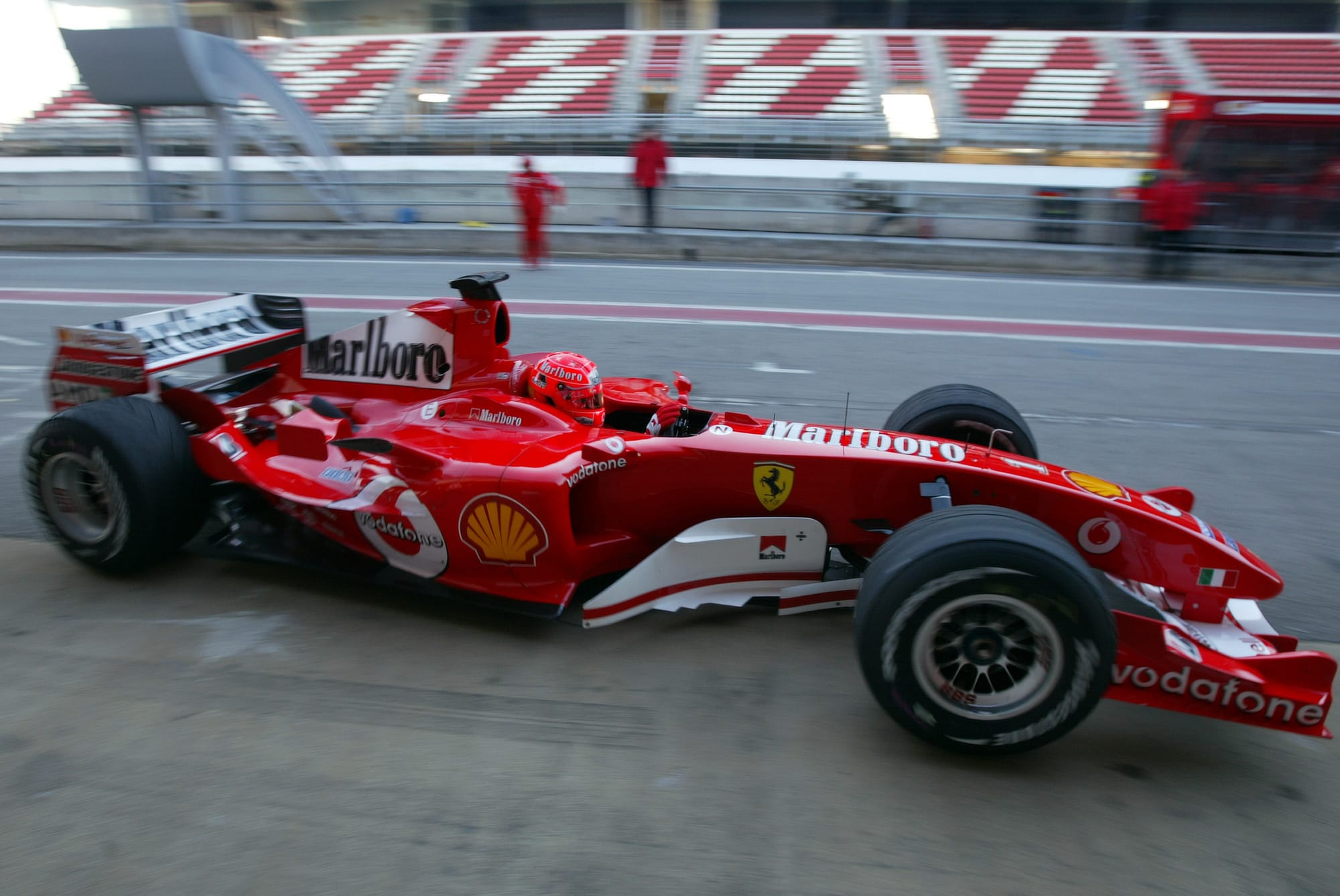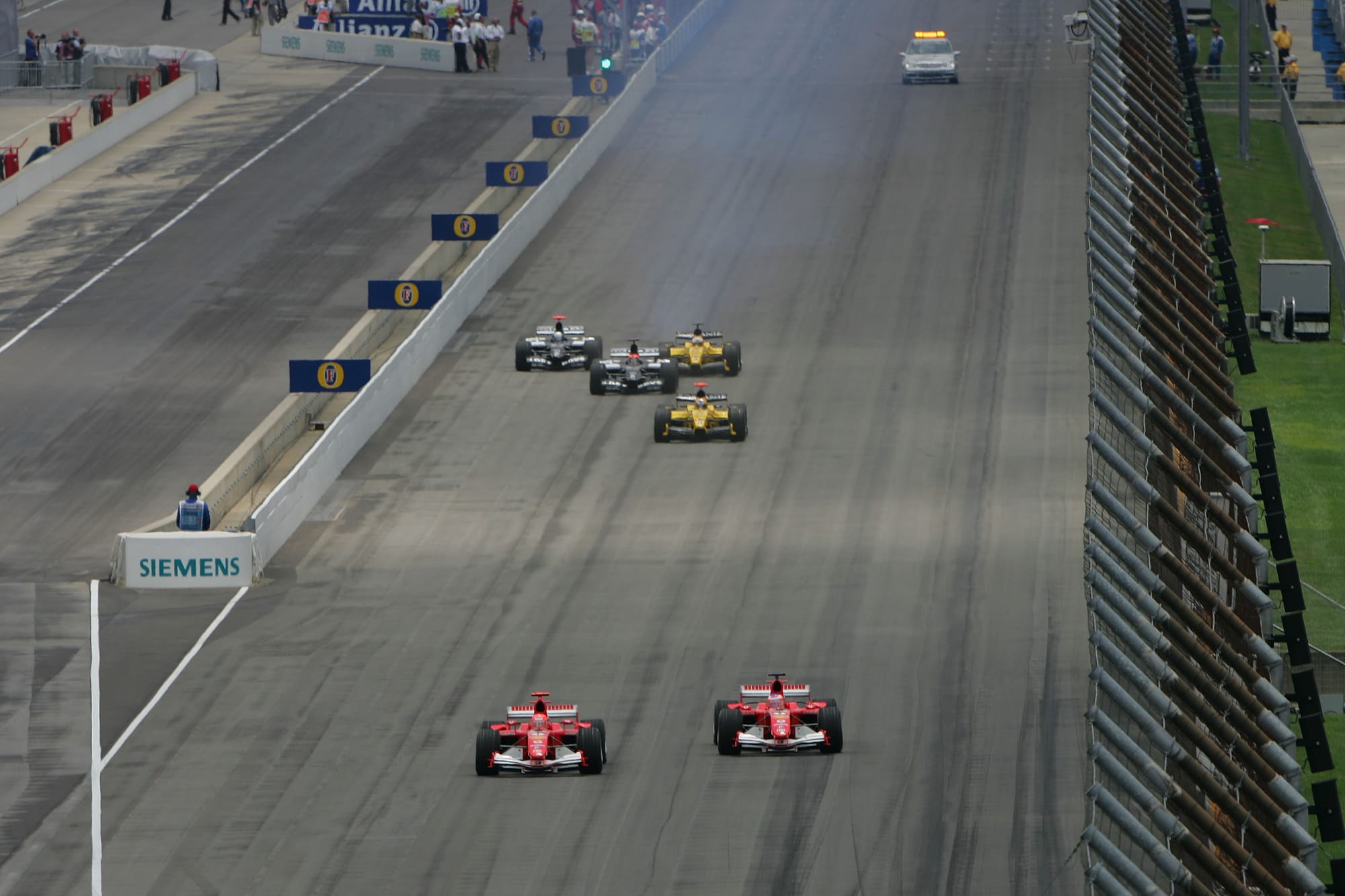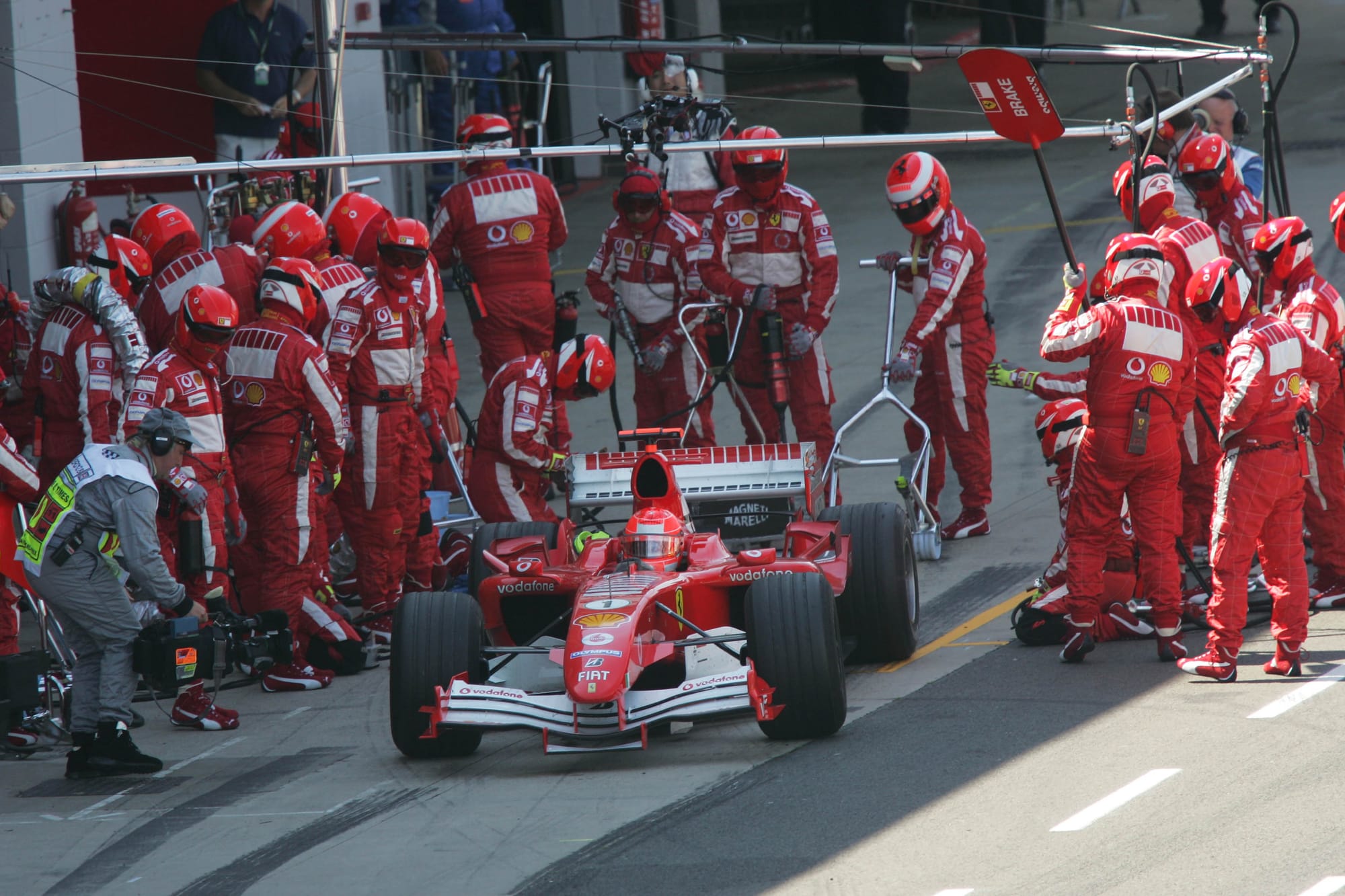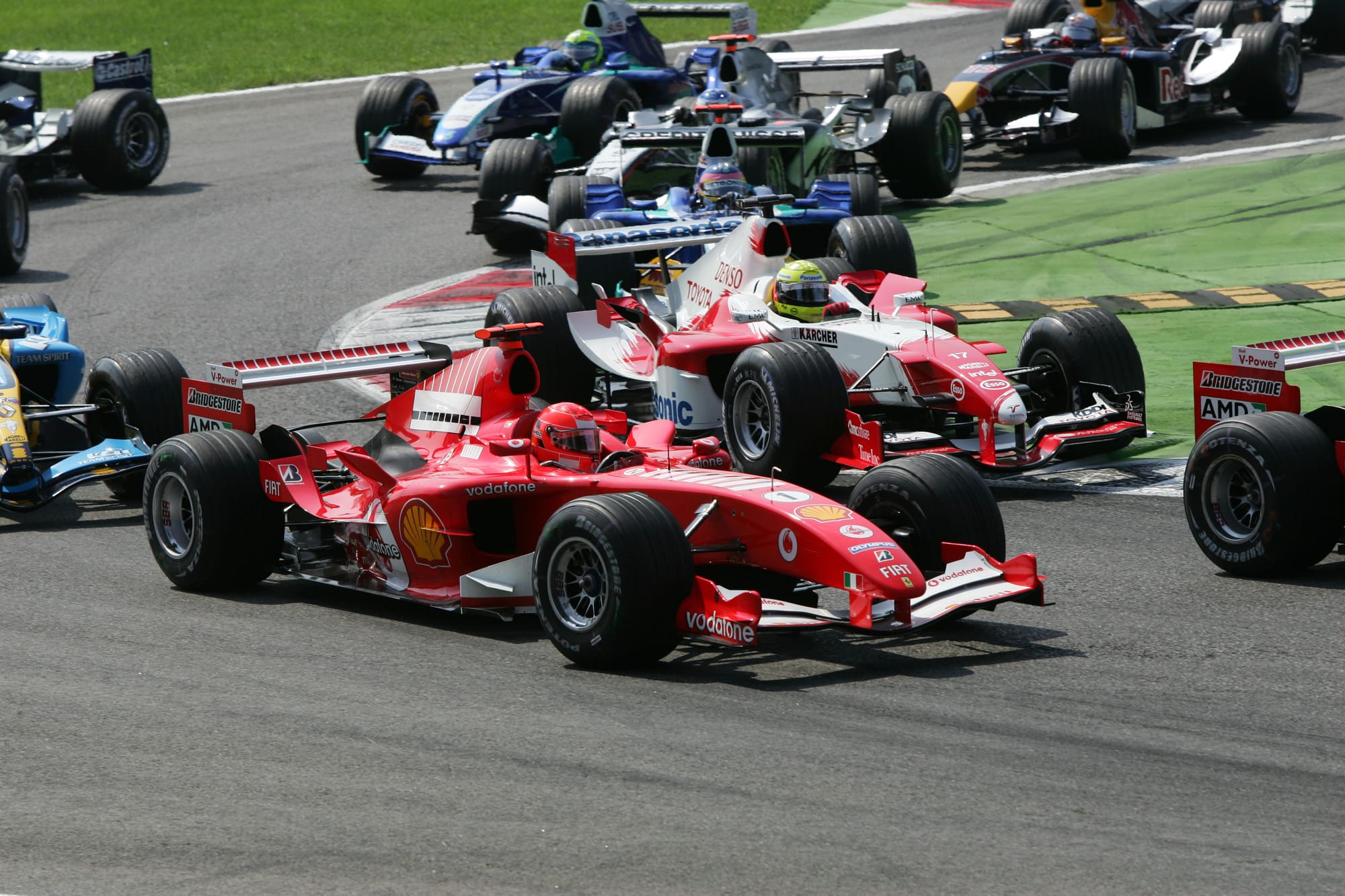“There was definitely a period when Ferrari was almost as good as it could get. I couldn't see how we could make it any better.
“We had a brilliant car, we had a technical team that was singing and all the crew were great, drivers were top class. It was difficult to see how it got any better.”
That was how former Formula 1 chief and multiple championship winning team boss Ross Brawn replied when asked during an appearance on Pirelli’s 500th GP episode of its Box Box Box YouTube show to name the “sweet spot” of his Formula 1 career.
He ranked it ahead of the fairytale Brawn GP story of rescuing the old Honda team and winning the title with it in its first and only season under his ownership, and of his early title successes with Benetton.
Ferrari dominated F1 from 2000 to 2004 with Michael Schumacher and Rubens Barrichello, taking consecutive championship clean sweeps - toppling McLaren in a close fight in 2000, resisting pressure from McLaren and Williams in 2003, but utterly destroying all opposition in 2001, 2002 and 2003. It won 67% of the races in that period.
Brawn reckons it wouldn’t have stopped there - if the rulemakers hadn’t intervened.
“And then of course we got nailed by the tyre rule change,” he continued.
“That was the one thing I didn't see coming. I don't know where Ferrari would have really stopped in that era if it hadn't been for the tyre rule change, because we were on top of it and that was the thing that just cut our legs off.”
This is what happened, as explained on our Bring Back V10s podcast back in its first season.
How Ferrari's domination was halted

How do you go from producing one of the most dominant F1 cars of all time, to just a year later having a car that was lucky to win a single race? In short, rule changes. Short-notice rule changes, too.
In June 2004 the World Motor Sport Council instructed the technical working group to come up with measures to slow the cars down for 2005.
When the TWG failed to agree anything within the two months it was given, the FIA submitted three proposals, and when the teams couldn’t agree on which of those proposals to choose, the FIA was allowed to choose one for them.
The package chosen brought in aerodynamic changes, the banning of tyre changes during races, and engines having to last two race weekends.
Brawn’s theory, that he outlines in his book, is that for the first couple of years of the 2000s F1 was “in heaven again” with Ferrari winning championships, but when it kept winning everyone started to view it as tedious.
He reckons FIA president Max Mosley took the pragmatic view that Ferrari was doing the best job, but that Bernie Ecclestone was “tearing his hair out” at the commercial damage being done by the same team and driver winning every time.
That created a political situation throughout Ferrari’s years of dominance where it was constantly fielding attempts to get rules changed to upset the competitive order. Brawn says in his book that Ferrari had to work out where to give concessions, because “if you just stonewall everything, then eventually they will knock the wall down and you have nothing, so you have to find some compromise”.
He says Ferrari usually wasn’t bothered by rule changes as the belief was it could do a better job than anyone else with whatever changes came in. However, he admits that part of his role was to steer some of the changes “a bit off course” to get them heading in a direction Ferrari felt it could deal with.
And he always wanted an 18-month lead time for rule changes to give Ferrari enough time to get their heads around them. Crucially for 2005, the teams (and the tyre suppliers) only had a matter of months.
Ferrari kept pretty quiet on the rule changes in public. Schumacher put something out on his website saying the performance of the cars and the effect the cornering forces were having on the drivers meant something had to be done, and chief mechanic Nigel Stepney said in December 2004 that the changes were the most significant since those made in the wake of the tragedies of Imola 1994.
But already by this point, with the rules firmly in place, Ferrari knew it was screwed. It had fostered an incredibly close working relationship with Bridgestone, to the point that no other top team would use the Japanese manufacturer.
Part of the mission to slow the cars down for 2005 was to force the tyre manufacturers to make harder tyres by saying one set had to last the entire race. Brawn recalls it was also suggested for environmental reasons, because so many tyres were being thrown away after only 20 laps of use.
In his book, Brawn says: “Over several years we had developed a sprint race philosophy where we did several pit stops. Bridgestone were developing soft, super-grippy, short-life tyres. We were developing cars with small fuel tanks. We were optimising that approach and we were focused on three or even four stop races.
“Max would have understood the implications. We were completely screwed, we didn’t have the knowledge of the rubber or the technology to make a one-race tyre. Michelin had a different approach to Bridgestone and their tyres got better as the race went on. We had a tyre that just fell apart and we couldn’t make one that was strong enough. We knew that the change in the rules on the tyres was a very serious threat, so I fought it, but the more we protested, the more they rubbed their hands.”
But Ferrari’s 2005 problems weren’t all about tyres. Other big changes were made to the cars too.
The front wing was raised, the rear wing was brought forward, the diffuser height was reduced and the bodywork in front of the rear wheels was cut back.
The FIA estimated these changes would result in a loss of “20% or more” of downforce with minimal loss of drag.

Ferrari started the season with a modified F2004, dubbed the F2004M. In pre-season it was clear the car was off the pace, and everyone was tipping McLaren and Renault to lead the way. But there was an element of caution, as even Renault was expecting Ferrari to be holding something back.
After a couple of races with an interim F2004 that didn't go well at all, Ferrari brought forward the debut of the F2005 by a couple of races - to the delight of Renault boss Flavio Briatore, who said that meant the car has been “rushed”.
Brawn offered a detailed insight into how the aerodynamic changes had hurt Ferrari as well:
“When the regulations became clear our transmission and engine package was not very good for them because, once you constrain the diffuser on the outside, the central part of the diffuser becomes much more important. So you have to expand the inside of the diffuser and then look at your engine and gearbox in a more extreme way. We decided we didn't have the right package, so we had to start again with the transmission.”
The F2005 looked quick on its debut in Bahrain but is unreliable. Then came one of the most memorable races from 2005: the San Marino Grand Prix.
Schumacher went off in qualifying so started 13th, but he charged through the field and hunted down Fernando Alonso, who held on in an epic duel.
It was a defeat for Ferrari, but as Schumacher crossed the line, his engineer Chris Dyer declares on the pit wall, “We’re back!”.
Schumacher called it a “stunning performance”, and singles out Bridgestone for special praise: “They have suffered in the first stages of the season from some bad publicity. The discussion about our tyres will surely come to an end now after our performance at Imola - we’re set to do really well at the next races.”
Schumacher’s pace advantage of nearly two seconds per lap at some points in the race had people suspecting Bridgestone had a good weekend and Michelin was off the pace. However, Schumacher declared “we’re back fighting for the championship”.
Yet Ferrari struggled over the next few races, with the general theme being a belief that the car is quick, but it couldn’t switch its tyres on for a single lap, so Schumacher and Barrichello qualified too far down the order then couldn’t make progress in the race.
There was a bright spot in Canada, where Schumacher qualified on the front row and the Ferraris finished second and third, although with some fortune as both Renaults and Juan Pablo Montoya’s McLaren fell by the wayside.

The messy anomaly of Indianapolis and all the Michelin teams pulling out handed Ferrari an unopposed 1-2 there, without which its final championship result would have looked even worse. Ferrari did feel it was having a good weekend even before the Michelin problems began.
Around this time, Brawn was already talking about Ferrari switching its attention to 2006, suggesting that if Ferrari poured all of its effort into 2005 and sacrificed the following year’s car, he was “not sure that would be the right choice”.
Ferrari president Luca di Montezemolo had been complaining all season, and used the saga as a chance to criticise the tyre rules rather than Michelin
“The fact that tyres can’t be changed during a race is against nature, so when there are problems they tend to be magnified resulting in what unfortunately happened in Indianapolis. In a championship I’ve long been defining as ‘of tyres’, sooner or later the risks of the most extreme innovations were almost inevitable,” he said.
In his book, Brawn says: “We were in a period where we were feeling very aggrieved because of what had gone on with the tyre rules, feeling persecuted. So our mindset was not to have much sympathy when the perpetrators of the one-race tyre had a problem.”
But the car was still a problem too. It was between 2004 and 2005 that Rory Byrne started to take a step back from leading the design team, with Aldo Costa being given much more responsibility.
As Ferrari’s season unravelled, the Italian media began to pick Costa as a scapegoat given the success of the Byrne-led designs in the previous years.
Brawn defended Costa aggressively, saying mid-season: “The philosophy behind the F2005 isn’t Costa’s, it’s the one employed by Ferrari over a number of years. Byrne wouldn’t have made a different car to the F2005, which is an excellent car on the basis of comparative tests we’ve done. The F2005’s working group is the one that created the F2004.
“Is it possible that all these engineers have become idiots? Costa will also be responsible for the 2006 car, and I hope, for many other cars to come. Both us and Bridgestone know we’ll come out of this situation.”
What developed over the summer of 2005 was a trend of Bridgestone bringing new tyre specs to races, and they were clearly aimed at improving the single-lap performance.
During this time, we also saw that Byrne had been tasked with seeing what Ferrari could do to help first-lap tyre performance, and he was behind new tyre heating ‘boxes’ that Ferrari’s rivals complained about. The idea was to do a better job of heating the whole rim and inside of the tyre, not just the surface. Charlie Whiting said the design was legal because inside it only used the normal heating elements you’d find inside a set of tyre blankets.

After the British Grand Prix Schumacher said Ferrari “appear to be going backwards instead of forwards”, and that during a race “our lap times get slower and slower”.
This was the opposite of the Michelin tyres, which seemed to get better as the race went on. One theory was that Bridgestone’s performance got worse the more Michelin rubber was laid on track. This was supported by Todt saying Bridgestone’s problems didn’t surface in testing, where the track isn’t rubbering up with Michelin tyres. Crucially this prevented Ferrari from being able to simulate the problem.
As Ferrari started to improve its qualifying performance, it quite often came at a price. Schumacher suffered a severe drop-off at the end of the German Grand Prix, falling out of the podium places, and in Hungary Ferrari was delighted to finish second after Schumacher qualified on pole, but he admitted that once he’d lost the lead to Kimi Raikkonen’s McLaren mid-way through the race he focused on managing his tyres to the end, and his pace dropped away so much that he’s 35 seconds behind Raikkonen and only just ahead of Ralf Schumacher’s Toyota by the finish.
Bridgestone’s new tyres were declared too soft for the new Turkish Grand Prix, and Ferrari had a woeful weekend. Schumacher, who collided with Mark Webber’s Williams, called it “our worst performance in a long time”, and a “major setback” for Ferrari after the progress of the summer.

Webber slated Schumacher for their collision, saying he was “very, very slow” and “out of order” for moving to defend too late. After so long used to only fighting at the front, there were definitely moments of clumsy racecraft for Schumacher in this very different season.
In testing ahead of the Italian Grand Prix - for which ticket sales were down on 2004 - Schumacher finally cracked on the subject of Bridgestone. Ferrari had done all it could to share the responsibility in public, but the hints from the likes of Todt got stronger and stronger as the year went on and then Schumacher couldn't keep it bottled up any longer.
“The car is the same - we are working very hard on the tyres but unfortunately we didn’t get it right,” he said.
“So far we have not found a solution to cure this problem. How can we be on pole position [In Hungary] if the car has a lack of mechanical grip?
“I think there is a very straightforward answer. It was so obvious that we did not have the grip we wanted to have in Turkey on the tyre side. I don't think we need to argue about that. It is too obvious. If I say anything else I will make myself look stupid and there is no point in doing so.
"Bridgestone is working very hard; we are a big team, we are a strong team and we had many successes, but we don't have it at the moment. I don't understand how to solve the problem.
“I don't think we need to talk about the car. We are good in two races but not good anywhere else. Maybe we are completely stupid not knowing how to work on the car, or the tyres don't work."

Both Ferraris were outside of the points at Monza, and things didn’t get any better from there. Somehow Schumacher finished third in the drivers’ championship, and Ferrari was third in the constructors, but that was more a reflection of the inconsistency of everyone else, and the 18 points picked up at Indy.
At the final race of the year in China Schumacher collided with Christijan Albers’ Minardi on the way to the grid, and spun out of the race behind the safety car. Todt summed the year up by saying it’s good to finish a bad season in a bad way because “it’s good to have your nose in the s**t so that you smell it clearly and react”.
Ferrari did react, with Schumacher nearly winning the 2006 championship, helped of course by the fact that tyre changes were reintroduced and Bridgestone was duly back in the game.
Michelin was livid about that change. It went into a war of words with the FIA over this, talking of “hidden motivations”, and a year later it walked away from F1, which wanted to move to a single supplier anyway to control costs and speeds.
Bridgestone stayed and supplied the whole field again until its own exit at the end 0f 2010. But Schumacher retired from F1 for the first time after his narrow 2006 title defeat to Alonso, Brawn soon headed for Honda and though Ferrari won another championship double in 2007 with Raikkonen leading its driver line-up and a constructors' crown via him and narrow drivers' title runner-up Felipe Massa in 2008, the days of absolute dominance have never been recaptured.



